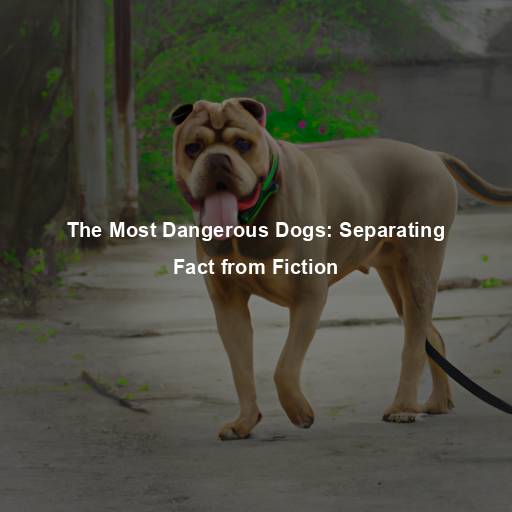The Most Dangerous Dogs: Separating Fact from Fiction
Last Updated on July 22, 2023 by Evan
Contents [hide]
- 1 Understanding the Controversy
- 2 Evaluating Dog Aggression
- 3 Debunking Breed Stereotypes
- 4 Factors Contributing to Aggressive Behavior
- 5 Promoting Responsible Dog Ownership
- 6 Understanding Dog Bite Statistics
- 7 The Importance of Early Socialization and Training
- 8 The Role of Responsible Breeding
- 9 Promoting Safe Interactions between Children and Dogs
- 10 The Role of Legislation and Enforcement
- 11 The Importance of Individual Assessment and Training
- 12 FAQs – What Dogs are the Most Dangerous?
- 12.1 What factors determine if a dog breed is considered dangerous?
- 12.2 What are some dog breeds often considered to be dangerous?
- 12.3 Are all dogs within these breeds aggressive?
- 12.4 Why do certain dog breeds have a higher risk of being dangerous?
- 12.5 How can I prevent dog-related accidents and ensure safety around any dog?
Understanding the Controversy
The world of canines is a realm brimming with passionate discourse and enigmatic complexity when it comes to the topic of dangerous dogs. Like fragments of a shattered mirror, myriad opinions and misconceptions reflect onto certain dog breeds, swirling into a bewildering tapestry of preconceived notions. But where does the truth lie, hidden beneath this enigma? Is there an inherent danger that lingers among certain canine companions, or is it merely an illusion we construct?
Evaluating Dog Aggression
Understanding the complexities of canine aggression requires delving into a tangled web of genetic predispositions, socialization nuances, and the intricate tapestry of individual temperament. While it is imperative to dispel the notion that aggression is the exclusive domain of specific breeds, it is true that certain dogs may exhibit a greater proclivity towards this behavior owing to their historical functions or unique genetic makeup. Nevertheless, it remains paramount to approach the assessment of aggression on an individual level, casting aside sweeping generalizations that may unfairly stigmatize entire breeds. The puzzle of aggression in dogs demands an astute and discerning evaluation that accounts for the diverse factors at play.
Nature vs. Nurture: The Role of Genetics and Environment
When discussing dog aggression, it is essential to consider the interplay between nature and nurture. Genetics can influence a dog’s predisposition towards certain behaviors, including aggression. However, environmental factors, such as socialization, training, and upbringing, also play a significant role in shaping a dog’s behavior. It is a combination of these factors that ultimately determines a dog’s temperament and potential for aggression.
Debunking Breed Stereotypes
The Pitfall of Breed Stereotyping
One of the most pervasive misconceptions surrounding dangerous dogs is the practice of breed stereotyping. Certain breeds, such as Pit Bulls and Rottweilers, have unfairly gained a reputation for being inherently dangerous. However, it is crucial to recognize that breed alone does not determine a dog’s level of aggression. Generalizing an entire breed based on the actions of a few individuals is both unfair and unfounded.
The Influence of Media Portrayals
In our ever-evolving media landscape, the power of storytelling is undeniable. However, we must be cautious of the unintended consequences that come with sensationalism and biased reporting. When it comes to our beloved furry friends, the portrayal of breed stereotypes is a delicate matter. All too often, we find ourselves caught in a web of captivating narratives that overshadow the truth and perpetuate unjust fear and prejudice towards certain breeds.
The Importance of Responsible Ownership
Rather than focusing on specific breeds, it is crucial to emphasize responsible dog ownership as a means of preventing aggressive behavior. Proper socialization, training, and responsible breeding practices are essential components of responsible ownership. By ensuring that dogs are raised in a nurturing and structured environment, the likelihood of aggressive behavior can be significantly reduced.
Factors Contributing to Aggressive Behavior
Lack of Socialization and Training
The path to understanding our furry friends can sometimes be a winding and bewildering one. As we navigate the complex world of dog behavior, we uncover a captivating truth: the undercurrents of aggression can often trace back to a dearth of socialization and inadequate training. When our canine companions miss out on the kaleidoscope of experiences that shape their early years, they may find themselves adrift in a sea of fear and anxiety, leading them down a path of reactivity and aggression. It is these delicate intricacies that compel us to dive deeper into the enigma that is our four-legged companions.
Negative Experiences and Trauma
It’s truly heartbreaking how past negative experiences can shape a dog’s behavior, often leaving them with deep-rooted fear and aggression. Mistreated dogs deserve our utmost empathy and support as they navigate the difficult path towards healing. The key lies in approaching these dogs with a compassionate mindset, seeking professional guidance to provide them with the tools and understanding they need to overcome their trauma.
Lack of Responsible Breeding Practices
Irresponsible breeding practices can contribute to the development of aggressive traits in certain dog breeds. Breeders who prioritize physical appearance over temperament and health may inadvertently perpetuate genetic predispositions towards aggression. Responsible breeding practices that prioritize temperament and well-being can help mitigate these risks.
Promoting Responsible Dog Ownership
Education and Awareness
In a world where dog aggression seems to loom in the shadows, shedding light on responsible dog ownership is vital. We must unravel the mystery surrounding this pressing issue by educating ourselves and raising awareness. By championing proper socialization, training, and responsible breeding practices, we can unravel misconceptions and foster a safer, more compassionate environment for our furry friends.
Encouraging Breed Neutrality
Moving away from breed-specific legislation and focusing instead on individual dog behavior can help promote a more balanced and fair approach to dog ownership. By recognizing that any dog, regardless of breed, has the potential for aggression, we can shift the narrative towards responsible ownership and prevention rather than perpetuating stereotypes.
Understanding Breed-Specific Legislation
Breed-specific legislation (BSL) refers to laws and regulations that target specific dog breeds deemed to be dangerous or aggressive. These laws often impose restrictions on ownership, such as mandatory muzzling, higher insurance requirements, or even outright bans on certain breeds. While the intention behind BSL is to enhance public safety, its effectiveness and ethical implications have been widely debated.
Critiques of Breed-Specific Legislation
There exists a swirling debate surrounding the effectiveness of Breed-Specific Legislation (BSL) in tackling dog aggression. Detractors contend that this approach simplifies a complex issue and overlooks the root causes that fuel aggression. Moreover, they argue that this legislation unjustly stigmatizes responsible owners of designated breeds, while failing to allocate resources towards more impactful solutions like educating owners and law enforcement. As opinions collide, the perplexing question remains – can BSL truly address the complexities of dog aggression, or are there alternative avenues that deserve more attention and scrutiny?
Alternative Approaches to Promote Public Safety
In a world where public safety concerns loom large, experts are urging for a shift in perspective. Instead of fixating on breed-specific legislation, a more holistic and inclusive approach is being championed. This novel approach zeroes in on responsible dog ownership, prioritizing essential elements such as proper training, socialization, and the rigorous enforcement of existing laws governing animal welfare and the menace of dangerous dog behavior. By delving into the core of the issue, irrespective of breed, communities can tackle the origins of aggression head-on, paving the way for a safer and more harmonious coexistence.
Understanding Dog Bite Statistics
Interpreting Dog Bite Data
When it comes to dog bite statistics, one must approach them with a healthy dose of skepticism. While they are frequently used to discuss the issue of dangerous dogs, it is vital to consider the complexities surrounding these figures. Multiple variables can impact how dog bites are reported and recorded, such as differing methods of reporting, the subjective definition of what constitutes a “bite,” and the accuracy of identifying dog breeds. This intertwining web of factors means that relying solely on statistics might not give us a complete understanding of how widespread or severe dog bites truly are.
Factors Contributing to Dog Bites
When it comes to dogs and their bites, there are many factors at play that might leave you feeling bewildered. Fear, anxiety, territory issues, protecting resources, or even a perceived threat can all contribute to these unexpected encounters. It’s worth noting that these behaviors aren’t limited to certain breeds; any dog has the potential to display them. Nevertheless, let’s also remember that the overwhelming majority of dogs, regardless of their breed, are not inclined towards aggression when it comes to humans.
Preventing Dog Bites
In the quest to reduce dog bites, a multidimensional approach takes the lead, weaving together the threads of responsible ownership, comprehensive training, vital socialization, and enlightening education. By engaging in the noble task of educating not only dog owners but also the wider public about the intricacies of canine behavior, deciphering body language, and fostering appropriate interactions, we unravel a tapestry of safer encounters between the two species, cultivating a harmonious coexistence that quells the disquieting specter of confrontations.
The Importance of Early Socialization and Training
The Critical Period of Socialization
Early socialization, during the critical period between 3 and 14 weeks of age, plays a vital role in shaping a dog’s behavior and temperament. Exposing puppies to a wide range of positive experiences, including various people, animals, environments, and stimuli, helps them develop confidence, resilience, and appropriate social skills. Proper socialization can significantly reduce the likelihood of fear or aggression later in life.
Basic Obedience Training
Mastering obedience is absolutely crucial for any dog owner who truly takes responsibility for their furry companion. Teaching invaluable commands, such as sitting patiently, remaining in place, and returning promptly when called, not only ensures the dog’s overall safety and happiness, but also deepens the profound connection between owner and pet. The art of training acts as a driver of mental engagement, kindling impeccable conduct, and granting dogs a profound understanding of their integral roles within the family dynamic.
Seeking Professional Help
Sometimes, when dealing with our furry friends, there may arise a need for the expertise of a seasoned dog trainer or behaviorist. These gifted individuals possess a wealth of knowledge and experience to help us navigate the perplexing world of dog behavior. By enlisting their assistance, we can ensure that our canine companions receive the tailored guidance they require to address any behavioral issues, such as aggression, effectively. With the help of these professionals, we can confidently embark on a journey to transform our four-legged companions into well-behaved and harmonious members of our families.
The Role of Responsible Breeding
The Impact of Breeding Practices
There’s no denying that responsible breeding practices have a profound impact on the welfare of our beloved canines. Ethical breeders, driven by a noble commitment, place the utmost importance on the holistic health and delightful temperament of their furry companions, going beyond mere superficial charm. With a discerning eye, they meticulously select and pair dogs who boast both impeccable temperaments and a clean bill of genetic health, effectively curbing the risk of aggression and other potential behavioral hurdles. In this perplexing world of dog breeding, their focus on well-being triumphs over mere aesthetics.
Avoiding Puppy Mills and Backyard Breeders
Puppy mills and backyard breeders are sources of poorly bred dogs with unknown lineage and potentially problematic temperaments. Dogs from these sources may be more prone to aggression due to improper socialization, genetic issues, and inadequate care. It is essential to avoid supporting these unethical breeding practices and instead seek dogs from reputable breeders or consider adopting from shelters or rescue organizations.
Promoting Responsible Dog Ownership
Public education and awareness campaigns play a vital role in promoting responsible dog ownership and preventing dog-related incidents. These initiatives can provide valuable information on topics such as proper training techniques, socialization, and understanding dog behavior. By equipping individuals with knowledge and resources, we can empower them to be responsible dog owners and reduce the risk of aggression.
Addressing Misconceptions and Stereotypes
Education and awareness efforts should also focus on dispelling misconceptions and stereotypes surrounding dangerous dogs. Providing accurate information about breed-specific behavior, the role of genetics, and the impact of responsible ownership can help challenge prevailing biases. By fostering a more informed and understanding society, we can create an environment that promotes fairness and compassion towards all breeds of dogs.
Collaboration with Community Organizations
Collaboration between animal welfare organizations, local authorities, and community groups is crucial in implementing effective education and awareness programs. By working together, these entities can pool their resources, expertise, and outreach capabilities to reach a broader audience and make a lasting impact. Public seminars, workshops, and community events can provide platforms for education and engagement.
Promoting Safe Interactions between Children and Dogs
Teaching Children about Dog Safety
Educating children about safe interactions with dogs is essential in preventing incidents and fostering positive relationships between children and animals. Teaching children to ask for permission before approaching a dog, how to read canine body language, and the importance of gentle and respectful behavior can help reduce the risk of bites or accidents. Parents, teachers, and community organizations should collaborate to incorporate dog safety education into school curricula and community programs.
Supervision and Guidance
Ensuring the safety and harmony between children and dogs during their interactions is of utmost importance. It is vital, particularly with younger children who may not grasp the concept of boundaries yet, that adults maintain a watchful eye to step in if needed. By establishing clear guidelines and offering guidance, we can create a safe environment that promotes the well-being of both children and dogs.
The Role of Legislation and Enforcement
Effective Legislation
The topic of breed-specific legislation can be quite controversial, with strong arguments on both sides. However, it is important to recognize that legislation, when thoughtfully crafted, can still contribute to the promotion of public safety. Rather than solely focusing on specific breeds, effective legislation should concentrate on addressing the root causes of dog-related incidents, such as irresponsible ownership and lack of enforcement. By implementing measures that encourage responsible ownership practices and promote responsible breeding, communities can strive to create a harmonious environment for humans and our beloved canine companions.
Enforcement and Accountability
Maintaining order in the world of furry friends is not just a walk in the park, but rather a perplexing puzzle that requires our undivided attention. It is absolutely paramount that we tackle the enforcement of animal control laws with a burst of determination to rein in instances of unruly behavior. To achieve this, our diligent animal control officers and law enforcement agencies must receive the necessary training and resources, arming them with the tools to effectively enforce these laws and bring to justice those who shirk their responsibilities. By pouncing on the opportunity to take quick and decisive action, we can safeguard the well-being of our canine companions and the public at large.
The Importance of Individual Assessment and Training
Professional Assessment
When dealing with potentially dangerous dogs, it is essential to involve professionals such as certified dog behaviorists or trainers. These experts can conduct thorough assessments to evaluate a dog’s behavior, determine its potential for aggression, and develop a tailored behavior modification plan. Individual assessment ensures that dogs are treated based on their specific needs and that appropriate training techniques are employed.
Behavior Modification Techniques
Discover the remarkable world of behavior modification techniques that have been found to be highly effective in curbing aggression in our beloved canine companions. By utilizing methods such as desensitization and counter-conditioning, we delve deeper into the realm of changing dogs’ emotional responses to the triggers that fuel their aggressive behavior. Supported by expert guidance, dog owners can easily master the art of implementing these techniques with utmost safety and remarkable success, ensuring their furry friends overcome any lingering aggressive tendencies with resounding triumph.
FAQs – What Dogs are the Most Dangerous?
What factors determine if a dog breed is considered dangerous?
There are various factors to consider when examining whether a specific dog breed falls under the category of “dangerous.” One must delve into its historical background and original purpose, as well as take into account the dog’s physical attributes such as size and strength. Additionally, the dog’s temperament, as well as its upbringing and training experiences, are crucial elements to evaluate. It is vital to keep in mind that not all dogs within a particular breed will display hazardous behavior, as aspects like socialization and training greatly impact their demeanor.
What are some dog breeds often considered to be dangerous?
It is not uncommon for people to harbor concerns or reservations when it comes to certain dog breeds, given the historical implications associated with their behavior. Among the breeds often mentioned in this context are the Pit Bull Terrier, Rottweiler, German Shepherd, Doberman Pinscher, and Akita. However, it is imperative to remember that each dog, regardless of its breed, possesses its own unique temperament and personality traits. While stereotypes may persist, it is essential to approach this subject with open-mindedness and recognize that generalizations do not always hold true in every case.
Are all dogs within these breeds aggressive?
Certainly, it is no secret that there is an ongoing debate surrounding the temperament of certain dog breeds. However, it is crucial to avoid generalizing and painting all dogs within these breeds with the same brush. The reality is that a dog’s behavior is influenced by a myriad of factors, including its upbringing, training, and individual personality traits. Therefore, it is imperative that we shift our focus to evaluating dogs on an individual basis rather than relying solely on preconceived notions and breed stereotypes. Many responsible owners have successfully raised well-behaved and loving dogs from breeds that have been unfairly stigmatized, showing that there is much more at play than a simplified breed label.
Why do certain dog breeds have a higher risk of being dangerous?
When it comes to canine companions, certain breeds might raise eyebrows and stir up debates about their potential for danger. The origins of these breeds, honed for specific purposes such as safeguarding livestock or offering unwavering protection, are often brought into the spotlight. It’s worth considering that larger and more brawny breeds could potentially cause greater harm if aggressive tendencies come to the forefront. Nonetheless, we must bear in mind that breed alone does not dictate aggression; the interplay of numerous factors, such as the dog’s surroundings and human interactions, adds intricate layers to this puzzle.
Ensuring the safety of both humans and our beloved four-legged friends requires a deep commitment to responsible dog ownership. When it comes to preventing dog-related accidents, one cannot underestimate the importance of proper socialization and early training for your furry companion. Giving them the opportunity to interact with others in a controlled environment and providing regular mental and physical exercise is crucial in maintaining their well-being. Equally important is the responsibility we hold as caretakers to supervise interactions between children and dogs, instilling in them the knowledge and respect needed to approach and engage with dogs safely. By familiarizing ourselves with dog behavior and body language, we can decipher their cues and protect ourselves and others from potentially risky situations.






